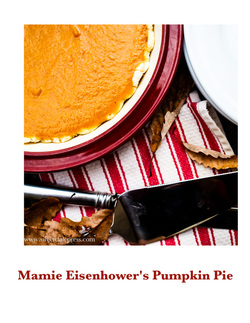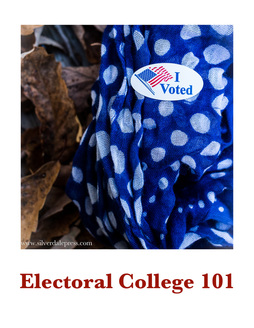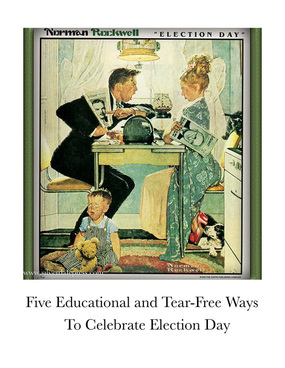 Happy Thanksgiving to you! In the wake of this frantic election season, this is a good time to reflect on the blessings of our democracy and our constitutional system of government. In the spirit of the presidency and thankfulness, I have three ideas for your homeschool this post-election Thanksgiving week (the third one involves pie and a recipe). 1. Read George Washington's 1789 Thanksgiving proclamation to your children George Washington was the first president to declare a national day of Thanksgiving--in 1789, the year the Constitution was ratified. His words remind us of what the country had--and still has--to be thankful for. Washington was especially thankful "for the peaceable and rational manner in which we have been enabled to establish constitutions of government for our safety and happiness, and particularly the national one now lately instituted." Establishing the Constitution was no easy task. We had just fought a bloody war with Britain to gain independence. The first constitution--the Articles of Confederation--was a disaster. And there were many who opposed the Constitution, which is now the world's oldest. We should be thankful that ours is a government of laws, not of men. 2. Watch Donald Trump and Barack Obama's press remarks following their first meeting Many countries around the globe do not enjoy peaceful transitions of power between rulers. It is nothing short of a miracle that we do enjoy this in the United States. Regardless of whether your candidate won, all Americans should be thankful for the peaceful transition of power. It shows that our country is safe and secure. 3. Bake Mamie Eisenhower's Pumpkin Pie When I think of Mamie Eisenhower's pumpkin pie, I think of prosperity. Mamie Eisenhower was first lady in the 1950s, a time of economic boom preceded by a period of depression and war. In the 1950s, Americans were cooking, celebrating, and consuming. Magazines wanted to know all of the details of Mamie's domestic life, including what was on her Thanksgiving table. Mamie's pumpkin pie even uses gelatin, the popular postwar thickening agent. I made Mamie's pie with my kids this week, and we had a great time. Consider bringing Mamie's pie to your Thanksgiving Day gathering. May it remind you to be thankful for our country's prosperity. Enjoy! Mamie Eisenhower's Pumpkin Pie 3 beaten egg yolks 3/4 cup brown sugar 21/2 cups cooks pumpkin (canned is fine) 1/2 cup milk 1/2 teaspoon salt 1 teaspoon cinnamon 1/2 teaspoon nutmeg 1 envelope Knox gelatin 1/4 cup cold water 3 stiffly beaten egg whites 1/4 cup granulated sugar One (baked) pie shell Combine egg yolks, brown sugar, pumpkin, milk, salt and spices. Cook in double boiler until thick, stirring constantly. Soak gelatin in cold water, stir into hot mixture. Chill until partly set. Beat egg whites, add granulated sugar, and beat stiff. Fold into pumpkin/gelatin mixture. Pour into pie shell and chill until set. Garnish with whipped cream.
1 Comment
 Wow! I was surprised by the election results, as were many around the country. Experts, pundits, and average citizens alike will spend the following days and weeks trying to figure out how political outsider Trump pulled off the incredible win over consummate insider Clinton. So, how did it happen? The answer: Trump forged a winning Electoral College coalition. Election Day always leaves people puzzling over how our presidential election system works. It is confusing. Presidents are not elected directly by the popular vote. Instead, they must win a majority of Electoral College votes. How It Works: Voters go to the polls in the individual states and then vote for a candidate on the ballot. The votes are then tallied in order to determine who received the most votes in the state. For the candidate who gets the most votes, the individual electors from the candidate’s party gets to cast all of the electoral votes in the state. This is called the “winner-take-all” method. Maine and Nebraska exceptions: These states use the “Congressional District Method.” With this method, a state is divided into its congressional districts, and the winner of each district is awarded that district’s electoral vote, and the winner of the state-wide vote is then awarded the state’s remaining 2 electoral votes. (Note that Maine's result this year was split). How Electoral Votes Are Calculated: The number of electoral votes a state gets is calculated by adding the number of congressional districts or representatives for each state (and this is based on population) to the number of senators (2 for each state). So, that’s why bigger states have more representatives and thus more electoral votes. Pennsylvania, for example, has 18 congressional districts, so how many electoral votes does it have? That’s right: 20. 270: The Magic Number A candidate needs 270 electoral votes in order to win. Flip down a few slides for a mathematical illustration of how this number is derived. Note that Washington, DC, which does not have any voting members in Congress, is given 3 electoral votes by the Constitution. Interestingly, DC has 3 electors because the Constitution says in the 23rd Amendment that it can’t have more than the least populous state. So, the total is 538. The winning candidate needs to secure a majority of the electoral votes. How do you get a majority? Divide 538 by 2 and add one. Here's the Formula: 435 (total number of house districts/members) + 100 (total number of senators) = 535 535+ 3 (number of electors allotted to DC) = 538 (538 / 2) + 1 = 270 Party Control of Elector Selection and Electoral College Voting The states nominate electors through the political parties. Each state has its own specific method of doing this--from state party conventions to campaign committees. In the Electoral College, if the Democrat wins, the Democratic electors get to vote, and Republicans do not…and vice versa if the Republican wins in the state. The Electoral College in 2016 Trump and the Republican National Committee successfully targeted swing states with large shares of Electoral College votes. They focused registration, turnout, and advertising in these states, especially Florida, Ohio, and Pennsylvania. He also focused on Michigan and Wisconsin, which had not voted Republican in years, and Iowa, which has been a swing state. Want to teach your children about the Electoral College and understand how Trump won? Here are some steps you can take: 1. Review the above information with them. 2. Download and print a blank 2016 electoral map. You can find one here or do an electronic one here. 3. Then find an interactive map online. Politico has a good one here. Starting on the East Coast, click on each state to see the results from the popular vote and how they informed the Electoral College vote. 4. On your blank map, have your child color states that Trump won in red and states that Clinton won in blue. 5. Meanwhile, keep a running tally of Electoral College votes for Trump and Clinton. Add them up. This will show your student how Trump got the needed 270 votes.  Do your feelings about this year's presidential election match anybody pictured in this Norman Rockwell painting, Election Day? Fear not. It's almost here: the first Tuesday after the first Monday in November! In this post, I'll give you some ideas about what to do with your homeschoolers to celebrate Election Day. I heartily believe that your family should mark the occasion. 1. Take your kids with you to vote. There is no better way to instill good citizenship values than by taking your kids with you to vote. I will be taking mine. Voting is the most frequently exercised form of political participation, and it is up to parents to set a good example. I have vivid memories of going with my parents to the polls, looking at the ballots, seeing how the process worked. Many precincts will have kids' voting stations set up, where kids who are under eighteen can cast their own ballots (that are not officially counted, obviously). After you come home, talk about what you observed--about the people and signs outside, who and what you encountered when you were inside, whether you had to present identification, who was on the ballot and so forth. Ask your children if they have any questions. 2. Volunteer at the polls. Campaigns are always looking for people to stand outside of the polling places to hand out literature and sample ballots. I just responded to an email requesting that I work the polls on Election Day for my local congresswoman, since I had done some volunteer work for her. The campaign manager was looking for people who could approach voters as they go into the polling place and hand out information. This is great experience too. Contact your local party organizations, or even contact the campaigns of people farther down the ballot (U.S. Congress, state legislature, governor, mayor, town council, etc.) to see if they need help. I'm sure they do. Of course, parents should volunteer together with their kids. 3. Teach your kids not to take voting rights for granted. Read President Lyndon Johnson's famous 1965 speech, which he delivered to persuade Congress to pass the Voting Rights Act. Or read suffragist Carrie Chapman Catt's speech to Congress imploring them to grant women the right to vote. 4. Get something for free. After you vote, take advantage of one of the many Election Day freebies from retailers around the country. 5. Gather together to watch the returns. In the past, I have really loved going to election night returns parties. I'd gather with friends around the television and watch the results come in. It is a good time to explain to your kids how news networks use exit polls to "call" the states before all of the ballots are counted. (However, I've been reading some articles lately about how party hosts are planning carefully, since emotions have been running high in this election). But if a party is in the plan, don't forget to follow us on Pinterest for some patriotic food ideas. |
Silverdale PressCheck out our About Page to learn more about us! Categories |

 RSS Feed
RSS Feed